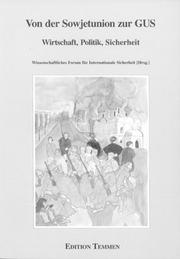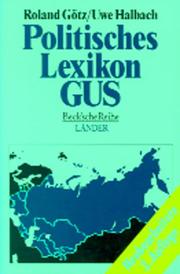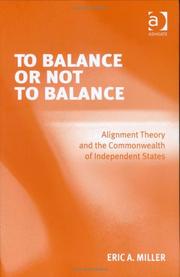| Listing 1 - 10 of 223 | << page >> |
Sort by
|

ISBN: 3861083051 Year: 1992 Publisher: Temmen
Abstract | Keywords | Export | Availability | Bookmark
 Loading...
Loading...Choose an application
- Reference Manager
- EndNote
- RefWorks (Direct export to RefWorks)
Post-communism --- Congresses --- Commonwealth of Independent States

ISBN: 3406405975 Year: 1996 Publisher: München Verlag C.H. Beck
Abstract | Keywords | Export | Availability | Bookmark
 Loading...
Loading...Choose an application
- Reference Manager
- EndNote
- RefWorks (Direct export to RefWorks)
Book
ISBN: 5282013835 Year: 1992 Publisher: Moskva Ekonomika
Abstract | Keywords | Export | Availability | Bookmark
 Loading...
Loading...Choose an application
- Reference Manager
- EndNote
- RefWorks (Direct export to RefWorks)
Business enterprises --- Entrepreneurship --- Commonwealth of Independent States.
Book
Year: 1998 Publisher: London : Brassey's,
Abstract | Keywords | Export | Availability | Bookmark
 Loading...
Loading...Choose an application
- Reference Manager
- EndNote
- RefWorks (Direct export to RefWorks)
Book
ISBN: 3804687679 Year: 1994 Publisher: Bielefeld Wissenschaft und Politik
Abstract | Keywords | Export | Availability | Bookmark
 Loading...
Loading...Choose an application
- Reference Manager
- EndNote
- RefWorks (Direct export to RefWorks)
Commonwealth of Independent States. --- Europe --- Former Soviet republics --- Foreign relations
Book
Year: 1993 Publisher: Santa Monica, CA : RAND Corporation,
Abstract | Keywords | Export | Availability | Bookmark
 Loading...
Loading...Choose an application
- Reference Manager
- EndNote
- RefWorks (Direct export to RefWorks)
This report describes and analyzes the structures, access, and declassification procedures within the post-Soviet archives. Although there are numerous holdings within former Soviet territory which collected and housed materials between 1917 and 1991, only those associated with the top leadership bodies (the CPSU Politburo, Secretariat, and Central Committee); the diplomatic, security, and intelligence services (the NKVD, KGB, and GRU); and the former Soviet military are examined. These include the Center for the Preservation of Contemporary Documents, Russian Center of Conservation and Study of Records for Modern History, Russian State Archives, the Russian Foreign Policy Archives, the Imperial Russian Foreign Policy Archives, the Russian Presidential Archives, the KGB Archives, the GRU Archives, and the CIS Military Archives. Overall, declassification will remain a key obstacle to any quick access to records in the post-Soviet archives. Throughout the archival system, managers and archivists complain bitterly about the lack of funds and manpower needed to peel away years of secrecy. One manager stated that it will take a decade before any materials can be released based on current funding levels. Thus many archives turn to Western interests for future funding opportunities to declassify materials quicker. Pressure must be applied to other Russian institutions to allow a quickening of declassification. KGB, GRU, and CIS military archives must be opened to Western specialists through negotiation with these institutions and not through the Russian government organs. However, secrecy on certain issues should be respected since materials can be damaging to both Russian and U.S. interests. The author gathered most of the information found within this document through interviews with Russian archival officials during a visit to Moscow between May 23 through May 31, 1992.

ISBN: 0754643344 Year: 2006 Publisher: Aldershot : Ashgate,
Abstract | Keywords | Export | Availability | Bookmark
 Loading...
Loading...Choose an application
- Reference Manager
- EndNote
- RefWorks (Direct export to RefWorks)
Book
ISBN: 1947098233 Year: 2017 Publisher: New York, New York : Business Expert Press,
Abstract | Keywords | Export | Availability | Bookmark
 Loading...
Loading...Choose an application
- Reference Manager
- EndNote
- RefWorks (Direct export to RefWorks)
The year 2016 marks the 25th anniversary of the official inauguration of the Commonwealth of Independent States (CIS), a free association of sovereign states comprised of Russia and 11 other republics that were formerly part of the Soviet Union (The CIS--Belarus, Moldova, and Ukraine; the South Caucasus--Azerbaijan, Armenia, Georgia) plus disconnected Abkhazia and South Ossetia; and Central Asia--Kazakhstan, Kyrgyzstan, Tajikistan, Turkmenistan, and Uzbekistan. Although this loose association of states may not exist as a fixed-entity on the globe, it is believed that this bloc of countries will continue to build upon the various separate regions in the former Soviet space in the coming decade. Despite major differences country-to-country, groups within each state share many common economic, political, and cultural characteristics, which many hope will fade with the passing of those generations that remember the common state. In this context, the Russian Federation holds a unique position in the Euro-Pacific area. Separate, distinct, but still bordering these regions and related to all of them to differing degrees, in the 2010's Russia will step up efforts to become an independent center of gravity in Northern Eurasia. Leaning on its CIS allies and partners, Moscow is willing to fortify its stance vis-a-vis its geopolitical competitors--the European Union in the west, and China in the east. Nevertheless, the combination of factors that determined the plunge in the economy of the CIS since the second quarter of 2015 persists today. These factors included the sharp fall in commodities prices, restrictions on access to international capital markets due to sanctions against Russia and a deceleration in China, which is the region's main trading partner. Although economic conditions in most of the CIS economies are challenging, differences in growth dynamics persist. Oil and gas exporting countries, namely Azerbaijan, Kazakhstan, Russia, and Turkmenistan, are seeing economic conditions deteriorating rapidly because of the sharp fall in energy prices. Meanwhile, most of the labor-exporting countries (Armenia, Kyrgyzstan, Moldova, and Tajikistan) are seeing the deterioration in growth rates, mainly due to strong production in the agricultural sector and, in some cases, increased activity in the extractive sector. This book provides a regional analysis, as well as country scan, of the CIS regional block economies. We will examine their history since the breakup of the formal Soviet Union and the formation of the CIS bloc, including creation of regional agreements such as the CIS Free Trade Area and the Eurasian Economic Union, a single economic market which now represents more than 180 million people. As a whole, our text attempts to better understand current, and future, prospects for economic growth in the region, as well as their individual national challenges.
Commonwealth of Independent States --- Economic history. --- Economic conditions. --- Politics and government. --- Economic conditions --- History, Economic --- Economics
Book
ISBN: 1509909486 1509928456 150990946X Year: 2020 Publisher: London, England : London, England : Hart Publishing, Bloomsbury Publishing,
Abstract | Keywords | Export | Availability | Bookmark
 Loading...
Loading...Choose an application
- Reference Manager
- EndNote
- RefWorks (Direct export to RefWorks)
This book undertakes the first comparative constitutional analysis of the Kyrgyz Republic and Republics of Kazakhstan, Turkmenistan, Uzbekistan, and Tajikistan in their cultural, historical, political, economic and social context. The enquiry probes the regional patterns of neo-Sovietism, plebiscitary elections, weak courts and parliaments, crony capitalism, and constraints on association, as well as the counter-tendencies that strengthen democracy, rights protection and pluralism. It reveals the Central Asian experience to be emblematic of the principal issues and tensions facing contemporary constitutional systems everywhere.
Film
Year: 2014 Publisher: London : Henry Stewart Talks,
Abstract | Keywords | Export | Availability | Bookmark
 Loading...
Loading...Choose an application
- Reference Manager
- EndNote
- RefWorks (Direct export to RefWorks)
Former Soviet republics --- Russia (Federation) --- Commerce. --- Commerce --- Commonwealth of Independent States. --- Commercial policy. --- Foreign economic relations
| Listing 1 - 10 of 223 | << page >> |
Sort by
|

 Search
Search Feedback
Feedback About UniCat
About UniCat  Help
Help News
News